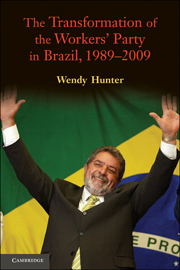Book contents
- Frontmatter
- Contents
- Tables, Charts, and Figure in Text
- Tables and Chart in the Appendix
- Acronyms
- Acknowledgments
- 1 Introduction: Understanding the Normalization of the Workers' Party
- 2 Strategic Change or Organizational Persistence? Evolution of the Workers' Party
- 3 Opposition Politics: The PT in the Chamber of Deputies
- 4 The PT in Municipal Government: The Pragmatic Face of the Party
- 5 Striving for the Presidency: From Opposition to Government
- 6 New Challenges and Opportunities: The PT in Government, 2003–2009
- 7 Analytical Implications and Comparative Perspectives
- Appendix
- References
- Interviews
- Index
7 - Analytical Implications and Comparative Perspectives
Published online by Cambridge University Press: 05 June 2012
- Frontmatter
- Contents
- Tables, Charts, and Figure in Text
- Tables and Chart in the Appendix
- Acronyms
- Acknowledgments
- 1 Introduction: Understanding the Normalization of the Workers' Party
- 2 Strategic Change or Organizational Persistence? Evolution of the Workers' Party
- 3 Opposition Politics: The PT in the Chamber of Deputies
- 4 The PT in Municipal Government: The Pragmatic Face of the Party
- 5 Striving for the Presidency: From Opposition to Government
- 6 New Challenges and Opportunities: The PT in Government, 2003–2009
- 7 Analytical Implications and Comparative Perspectives
- Appendix
- References
- Interviews
- Index
Summary
The PT is a case of the successful and fairly gradual transformation of a radical institutionalized mass party into a more electorally competitive professional party. Given its start as exceptionally ideological and grassroots oriented, it was the kind of party we might least expect to have reoriented in a vote-maximizing way. Ultimately, the PT did adapt but its adaptation was fairly slow – arguably slower than, for example, the Argentine Peronists, the Chilean Socialists, or the Argentine FREPASO. After three failed presidential bids, the PT went on to win two consecutive presidential contests, an unprecedented feat for the left in Brazil. Although Lula had responded rationally to externally induced incentives (and persuaded significant elements in the party to go along with him), there was also internal resistance to change. The PT's origins and structure created lags and distortions in adaptation but also some real advantages, namely endowing the party with credibility as the voice of opposition in 2002, discipline in passing difficult reforms once Lula became president, and a reliable foundation that would help it weather a number of serious crises.
In this chapter I return to the analytical approaches that frame the book. I draw out the broader theoretical implications of the book's analysis after first revisiting the reasons for change within the PT and comparing anew the features of its adaptation that are explained by a strategic framework to those that historical institutionalism helps to understand.
- Type
- Chapter
- Information
- The Transformation of the Workers' Party in Brazil, 1989–2009 , pp. 177 - 200Publisher: Cambridge University PressPrint publication year: 2010

